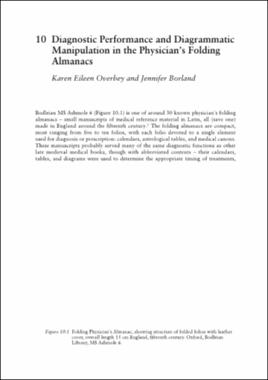| dc.description.abstract | Bodleian MS Ashmole 6 is one of around 30 known physician’s folding almanacs - small manuscripts of medical reference material in Latin, all (save one) made in England around the fifteenth century. The folding almanacs are compact, most ranging from five to ten folios, with each folio devoted to a single element used for diagnosis or prescription: calendars, astrological tables, and medical canons. These manuscripts probably served many of the same diagnostic functions as other late medieval medical books, though with abbreviated contents - their calendars, tables, and diagrams were used to determine the appropriate timing of treatments, 145including the administration of medicine as well as purging, bleeding, and cautery. What distinguishes the folding almanacs is their form: rather than a codex with quires sewn into a binding, each folio of the almanac is folded in half, and then again in thirds or sometimes fourths. Each sheet of parchment has a small, extended tab along one edge; when the folded sheets are stacked together, the tabs are gathered and stitched, often into a fabric or leather cover. With the folios folded this way, almanacs are also small in size: they are long and narrow, with folded dimensions averaging around 13 × 5 centimeters. This format, and the unusual binding, made the almanacs extremely portable. Some, such as Lambeth Palace MS 873, have been preserved along with leather cases, which may have protected them inside a purse; 3 others, such as Ashmole MS 6, still have their strong leather covers and a thick tab with an attached loop, to hang directly from its owner’s belt. 4 To use the information in the almanacs, a practitioner would detach the manuscript, turn to the relevant section, partially or fully unfold, refold, and unfold again. Rather than simply read as a diagnostic tool, the almanac requires manual handling: the images, charts, and texts were neither fixed nor held still in the hand, and in the process of treatment the almanac moved in the space between doctor and patient. Folding almanacs should thus be seen as part of a complex network in which patient, doctor, and book are all active, and in which the materiality of the almanac is instrumental. | |
